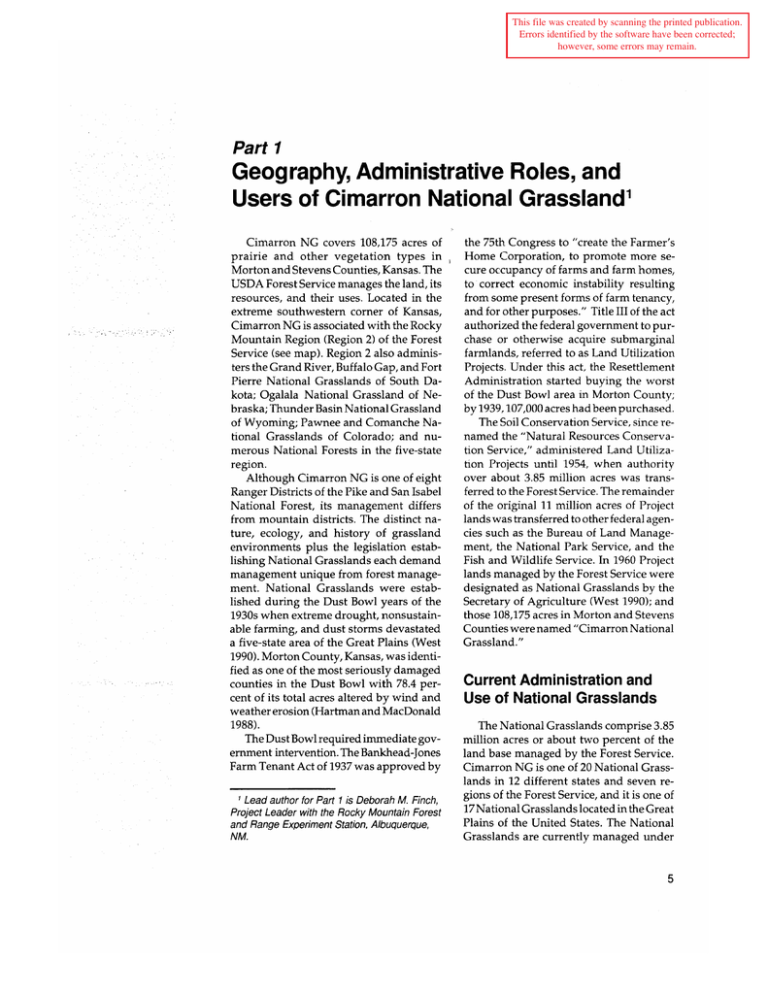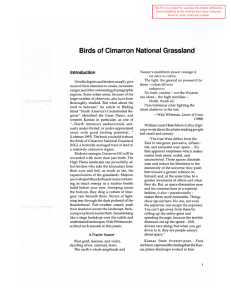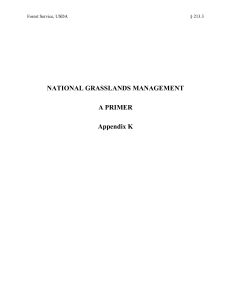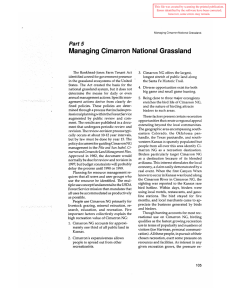Geography, Administrative Roles, and Users of Cimarron National Grassland Part 1 1
advertisement

This file was created by scanning the printed publication. Errors identified by the software have been corrected; however, some errors may remain. Part 1 Geography, Administrative Roles, and Users of Cimarron National Grassland 1 Cimarron NG covers 108,175 acres of prairie and other vegetation types in Morton and Stevens Counties, Kansas. The USDA Forest Service manages the land, its resources, and their uses. Located in the extreme southwestern corner of Kansas, Cimarron NG is associated with the Rocky Mountain Region (Region 2) of the Forest Service (see map). Region 2 also administers the Grand River, Buffalo Gap, and Fort Pierre National Grasslands of South Dakota; Ogalala National Grassland of Nebraska; Thunder Basin National Grassland of Wyoming; Pawnee and Comanche National Grasslands of Colorado; and numerous National Forests in the five-state region. Although Cimarron NG is one of eight Ranger Districts of the Pike and San Isabel National Forest, its management differs from mountain districts. The distinct nature, ecology, and history of grassland environments plus the legislation establishing National Grasslands each demand management unique from forest management. National Grasslands were established during the Dust Bowl years of the 1930s when extreme drought, nonsustainable farming, and dust storms devastated a five-state area of the Great Plains (West 1990). Morton County, Kansas, was identified as one of the most seriously damaged counties in the Dust Bowl with 78.4 percent of its total acres altered by wind and weather erosion (Hartman and MacDonald 1988). The Dust Bowl required immediate government intervention. The Bankhead-Jones Farm Tenant Act of 1937 was approved by 1 Lead author for Part 1 is Deborah M. Finch, Project Leader with the Rocky Mountain Forest and Range Experiment Station, Albuquerque, NM. the 75th Congress to crea te the Farmer's Home Corporation, to promote more secure occupancy of farms and farm homes, to correct economic instability resulting from some present forms of farm tenancy, and for other purposes." Title III of the act authorized the federal government to purchase or otherwise acquire submarginal farmlands, referred to as Land Utilization Projects. Under this act, the Resettlement Administration started buying the worst of the Dust Bowl area in Morton County; by 1939,107,000 acres had been purchased. The Soil Conservation Service, since renamed the "Natural Resources Conservation Service," administered Land Utilization Projects until 1954, when authority over about 3.85 million acres was transferred to the Forest Service. The remainder of the original 11 million acres of Project lands was transferred to other federal agencies such as the Bureau of Land Management, the National Park Service, and the Fish and Wildlife Service. In 1960 Project lands managed by the Forest Service were designated as National Grasslands by the Secretary of Agriculture (West 1990); and those 108,175 acres in Morton and Stevens Counties were named "Cimarron National Grassland. " II I Current Administration and Use of National Grasslands The National Grasslands comprise 3.85 million acres or about two percent of the land base managed by the Forest Service. Cimarron NG is one of 20 National Grasslands in 12 different states and seven regions of the Forest Service, and it is one of 17 National Grasslands located in the Great Plains of the United States. The National Grasslands are currently managed under 5 Part 1 Dust storms such as this one bearing down on a Kansas farm prompted the legislation that created the National Grasslands. So long as the wind blows. the threat of these kind of dust storms still exists. Photo courtesy of Morton County Historical Society. authority of the Bankhead-Jones Farm Tenant Act of 1937, which directs the Secretary of Agriculture to "develop a program of land conservation and land utilization, in order thereby to correct maladjustment in land use." By regulation the National Grasslands are "to demonstrate sound and practical principles of land use for the areas in which they are located." Characteristics shared in common among National Grasslands include their management authority, the importance of agriculture to local economies, energy and mineral development, intermingled land ownership patterns, dominance of grasslands, and management by grazing associations. Under the Bankhead-Jones mandate, the Cimarron Ranger District permits 120 ranchers to graze 5,000 cattle between 1 May and 31 October. To manage pastures and cattle movement, 496 miles of fence, 33 wells, and 125 windmills are maintained by district personnel and range rid- 6 ers provided by ranchers. With the enforcement of the Multiple-Use SustainedYield Act of 1960, the Forest Service has also had the flexibility to manage National Grasslands to include nonagricultural uses such as mineral development, recreation, conservation, research, and cultural heritage exhibits. Contributing to the local and regional economy, 23 developed oil/gas fields, 425 oil/ gas facilities and about 300 miles of gas pipeline are now present on Cimarron NG. Recrea tiona! opportunities include fishing, hunting, picnicking, camping, hiking, botanizing, birding, wildlife-viewing, photography, and history investigations. Eleven ponds, several hiking trails along the Cimarron River, off-road vehicle trails, two picnic areas with playgrounds, and a new campground are available for year round use. Crossing Cimarron are 23 miles of the Sante Fe Trail, the longest segment with public access. Visitors are welcome to Geography, Administrative Roles, and Users the Forest Service, and various state game retrace the steps of the trail pioneers on the parallel "Companion Trail." and fish agencies have worked together to Cimarron NG has one Research Natuincrease efforts to protect prairie wildlife, including threatened and endangered speral Area where scientists can study ecosyscies and migratory birds that use National tem dynamics in an undisturbed setting. Grasslands for breeding, wintering, and Research on livestock use and rangeland health of the grassland has provided an ' migration. Regulatory acts that legislate the conservation of species, habitats, and important source of information to land managers, ranchers, and scientists in Kan- I biological diversity on lands managed by the National Forest System of the USDA sas and other prairie states. With growing Forest Service are already in place. Federal scientific and public interest in cultural legislation on environmental protection resources, prairie ecosystems, and wildlife that applies to National Grasslands inconservation, additional research studies cludes the National Environmental Policy throughout the Grassland have focused on Act of 1969, the Endangered Species Act of human history, archaeology, fossils, soils, 1973, and the National Forest Manageplant communities, big game, prairie dogs, ment Act of 1976. endangered species, swift fox, Lesser As part of a Forest Service regional asPrairie-Chicken, other gamebirds, raptors, songbirds, and reptiles. sessment of biological diversity, Finch (992) combined and discussed the literaGrassland ecosystems of the Great Plains are recognized as important reserture on threatened, endangered, and senvoirs for biological diversity (Samson and sitive species in the five states of the Rocky Knopf 1994) and for populations of threatMountain Region. This review evaluated ened, endangered, and declining bird and ranked vulnerable bird species and populations (Finch 1992, Knopf 1992, Saab other wildlife in forest and grassland et al. 1995, Dobkin 1994). With the advent ecosystems, including Cimarron NG. Adin the 1980s and 1990s of bird conservation ditional literature reviews on grassland programs such as the National Waterfowl birds of the Great Plains were stimulated Management Plan (focusing on recovering by the Partners in Flight program implewaterfowl habitats and populations), the mented in 1991 by the National Fish and Playa Lake Joint Venture (focusing on conWildlife Foundation, the u.s. Fish and serving playas of the southern plains for Wildlife Service, the Forest Service, and waterfowl migration), and Partners in numerous other organizations (Finch 1991, Flight (focusing on conserving populations Finch and Stangel 1993, Martin and Finch and habitats of Neotropical migratory 1995). In response to the management needs landbirds, Finch and Stangel 1993), attenidentified by Partners in Flight, the Northtion to the National Grasslands as imporern Region of the Forest Service contracted tant habitats for studying and conserving production of a conservation and managebird populations has greatly increased. ment review, Neotropical Migrants in the Northern Rockies and Great Plains (Dobkin 1994). This book offers a strong scientific The Role of Bird basis for managing and conserving birds Conservation on in grassland ecosystems of the Great Plains. To manage migratory birds and their habiNational Grasslands tats more effectively, along with managRecently, organizations such as the Naing other uses such as livestock grazing tional Audubon Society, the Nature Conand mineral development, Finch et al. servancy, the National Fish and Wildlife (1993) recommended that bird conservaFoundation, the U.s. Fish and Wildlife tion be integrated into Forest Service plans Service, the National Biological Service, for ecosystem management. 7 Part 1 Cattle graze the shortgrass prairie near the Cimarron River. Photo by Ted Cable. To highlight increasing multi-organizational studies and concerns for grassland birds, the Association of Field Ornithologists and the Sutton Avian Research Center in cooperation with numerous other organizations, including the Forest Service, hosted the "International Conference and Training Workshop on Conservation and Ecology of Grassland Birds" held 26-28 October 1995 in Tulsa, Oklahoma. The product of this meeting, now in press as a special supplement to the Journal of Field Ornithology, will provide extensive information on conservation and management of grassland birds on private properties and public lands such as Cimarron NG. To meet these growing needs and values, many districts now inventory bird species and populations on National Grasslands and offer bird species checklists to the birder and recreationist. Cimarron NG 8 offers a free pamphlet titled "Birds of the Cimarron National Grassland" (Hartman and MacDonald 1988). Further, Cimarron NG actively develops habitat improvement projects and partnerships with numerous state, federal, and private groups to benefit a wide variety of game and nongame birds. Strong efforts have also been made by the Cimarron Ranger District to identify and advertise values and opportunities for birding, gamebird hunting, and other recreational activities on Cimarron (Hartman and MacDonald 1988). Such efforts have helped to generate a broader appeal for, and public interest in, National Grasslands and similar prairie ecosystems. This book results from the increasing interest in managing National Grasslands for multiple uses, including bird conservation, recreational birding, and gamebird hunting.





